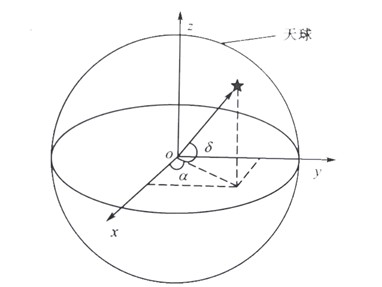Celestial bodies maintain relative balance via gravitation and motion. Visually, all celestial bodies seem to be equidistant, and their relationship to the observer is like the relationship between a point on a sphere and the center of the sphere. This imaginary sphere with the observer as the center and an arbitrary length as the radius is called the celestial sphere.
The star is the basic reference for running a star sensor. After many years of astronomical observations, each star has its own relatively fixed position in the celestial sphere. Generally, the position is represented by the right ascension and declination of the celestial spherical coordinates, and denoted as (α, δ), as shown in Figure 1-1. According to the relationship between rectangular coordinates and spherical coordinates, the direction vector of each star in the celestial rectangular coordinate system can be obtained as

At present, the angular position accuracy of navigation stars in star catalogs is generally magnitude 20mas, which can be considered precise enough compared to other errors within the star tracker development process. To form the navigation stars and the navigation star catalog, stars which meet the imaging conditions are selected. This navigation star catalog is fixed once in the memory of the star tracker on the ground.

Picture 1-1 The Descriptive Relationship of Navigation Stars in Celestial Spherical Coordinate System and Cartesian Coordinate System

